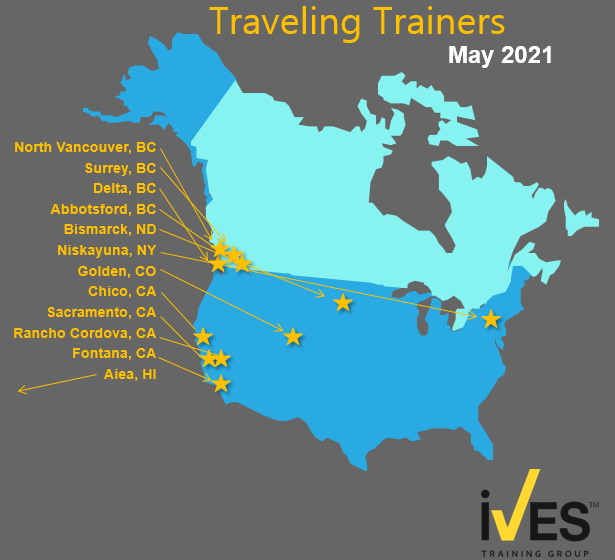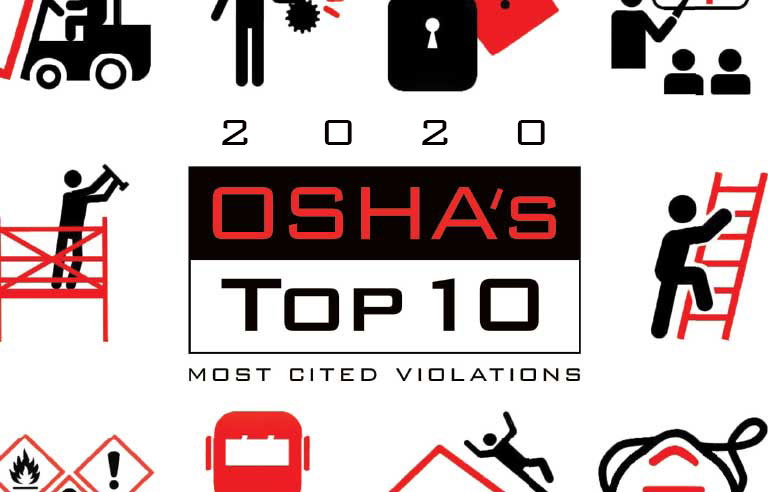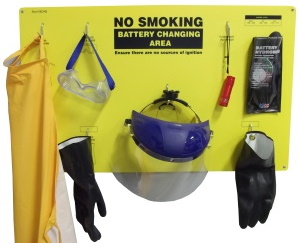In this issue, we will be covering:
- Understanding the training dilemma.
- OSHA's Top 10 Most Cited Violations 2020.
- Product Feature: Safety Equipment and Accessories.
- Upcoming Program Calendar.
- Incident Report: Death of Supervisor Results in $200,000 Fine.
- Ask Bob: Our tech guru answers a question on planning for multiple trainers.
- A selection of interesting articles.
- New testimonials from our wonderful clients.
But first, check out all the places we are delivering training this month...

Understanding the training dilemma

As a safety professional, have you ever faced resistance from management when you’ve proposed employee safety training initiatives? Chances are you’ve heard responses like: “We don’t have the time;” “We don’t have the budget;” or “I need you to condense that eight-hour training class into three hours.” The fact is training is costly.
Consider the ‘forgetting curve’
On top of the cost objection, according to research, up to 90 per cent of training is forgotten within seven days. The “forgetting curve” was hypothesized and tested by German psychologist Hermann Ebbinghaus. His research showed that when people first learn something, it disappears at an exponential rate. In fact, most learning is lost in the first couple of days. However, if we understand how learning occurs, then we can do something about the forgetting curve and demonstrate to management with confidence how they can deliver safety training that produces a return on investment. A key reason for the forgetting curve is that three parts of the brain are involved in learning retention and competency, and most training only engages one part of the brain — and at best two. Knowledge, application and competency reside in different parts of the brain.
Knowledge: Lets take forklift training, for example. When workers sit through the lecture, watch the videos, or read the safe work procedure on how to operate a forklift, neurons fire in the neocortex of the brain to log the new information by making new synaptic connections. The neocortex is the seat of our conscious awareness and where we store information. In 2000, Nobel Prize winner Eric Kandel found that if information is not reviewed or applied, the new circuits formed in the neocortex prune apart within hours or days. As the saying goes: “If you don’t use it, you lose it!”
Application: As they review their workbooks and watch the videos about how to operate the forklift, workers might be thinking “Hey, I’ve got this… This looks easy!” However, out in the parking lot when its time to apply what they have just intellectually learned, they find out that it’s actually not that easy. The forklift jerks forward, hydraulics go up when they were meant to go down, and the pallet gets dropped. The reason for difficulty is because “doing” or application resides in a different part of the brain — the limbic brain. The application of the new knowledge (or experience) causes jungles of neurons to organize into networks and the brain makes a chemical that activates the limbic brain to releases neuropeptides. Now the workers are beginning to chemically instruct and emotionally teach their body what the mind has intellectually understood. So, knowledge is for the mind (neocortex), but application or experience is for the body (limbic brain).
Competency: After a few weeks or months, the workers are so skilled at operating the forklift that they don’t have to consciously think about what they are doing. They can even be talking to another worker in the area all while scooping and setting a pallet perfectly. They have applied the knowledge enough times, so that now they no longer have to consciously think about it. When workers have repeated something over and over, it causes neural networks in the cerebellum, the storehouse of implicit (non-declarative) memory, to become highly enriched. Now, their body as the unconscious mind is operating the forklift, and neurochemically, mind and body have become as one. So, if learning is making new synaptic connections in the brain, then remembering is maintaining and sustaining those connections. Competency, then, is neuroconnections fired and wired through repeated application so that the worker can perform the task skillfully with their body as the unconscious mind — just like tying our shoelace. When we understand how the brain and body learn, we have a better understanding why the learning pyramid estimates retention at five to 10 per cent with lecture or reading alone.
Tips for better training outcomes
1. Make it meaningful: People are more likely to pay attention and retain information when they are interested in the content, and they understand how it practically applies to them.
2. Make it interactive: The more participants interact with the content, the more the brain has to fire and wire, and the better the learning and retention. For example, if people can turn to the person next to them end explain what they just learned, they are building a model of understanding.
3. Promote critical thinking: Build case studies and scenarios into your training program. As people apply what they have just learned immediately, the brain starts firing in new patterns, sequences, and combinations and the new neurosynaptic connections being formed are more likely to stick. Moreover, questions hook the brain, making people think. This then causes more neurons to fire and wire to promote learning and retention.
4. Deliver content in micro-courses: Instead of a full-day training program, consider breaking it down into three sessions of two hours each. Learning drops off significantly and even stops when people feel overloaded or overwhelmed.
5. Include application right away: Make sure people apply what they are learning. Remember that “experience” resides in a completely different part of the brain. For example, have students create the WHMIS workplace label, physically set up the ladder, practice running to get the AED and calling for help.
6. Test for understanding: Whether it’s a written test or a competency checklist — or both — it’s another way for the knowledge to be applied. It also measures the level of learning and provides a record for your company’s due diligence.
7. Revisit the material often: Send an email, hold a safety talk, and host short refresher courses often, so that the brain fires and wires into a long-lasting connection.
In summary, every year, organizations invest billions in performance-based training that fails to produce the desired results. Why? A primary reason is the inability to produce the sustained change required to have a lasting impact on human behavior. True and lasting change requires becoming aware of how the brain works and creating deep-seeded habits and beliefs that rest mostly in the unconscious mind.
Next time management pushes back on allocating safety training time or dollars, share your understanding of how learning occurs to help assure them why and how they’re going to get a return on their investment.
OSHA's Top 10 Most Cited Violations 2020

1. FALL PROTECTION – GENERAL REQUIREMENTS
Standard: 1926.501
Total Violations: 5,424
Fiscal Year 2019 Ranking: No.1 (7,014 Violations)
This standard outlines where fall protection is required, which systems are appropriate for given situations, the proper construction and installation of safety systems, and the proper supervision of employees to prevent falls. It's designed to protect employees on walking/working surfaces (horizontal or vertical) with an unprotected side or edge above 6 feet.
- 1926.501(b)(13): Each employee engaged in residential construction activities 6 feet or more above lower levels shall be protected by guardrail systems, safety net systems or personal fall arrest systems unless another provision in paragraph (b) of this section provides for alternative fall protection measures. - 3,563 violations.
- 1926.501 (b)(1): Each employee on a walking/working surface (horizontal or vertical surface) with an unprotected side or edge that is 6 feet or more above a lower level shall be protected from falling by the then use of guardrail systems, safety net systems or personal fall arrest systems. - 842
- 1926.501(b)(10): Except as otherwise provided in paragraph (b) of this section, each employee engaged in roofing activities on low-slope roofs, with unprotected sides and edges 6 feet or more above lower levels shall be protected by guardrail systems; safety net systems; personal fall arrest systems; or a combination of warning line system and guardrail systems, warning line and safety net system, warning line system and personal fall arrest system, or warning line system and safety monitoring system. - 371
- 1926.501(b)(11): Each employee on a steep roof with unprotected sides and edges 6 feet or more above lower levels shall be protected from falling by guardrail systems with toeboards, safety net systems or personal fall arrest systems. - 315
- 1926.501(b)(4): 'Holes" - 151
2. HAZARD COMMUNICATION
Standard: 1910.1200
Total Violations: 3,199
Fiscal Year 2019 Ranking: No.2 (4,170 Violations)
3. RESPIRATORY PROTECTION
Standard: 1910.134
Total Violations: 2,649
Fiscal Year 2019 Ranking: No5 (2,826 Violations)
4. SCAFFOLDING
Standard: 1926.451
Total Violations: 2,538
Fiscal Year 2019 Ranking: No.3 (3,228 Violations)
5. LADDERS
Standard: 1926.1053
Total Violations: 2,129
Fiscal Year 2019 Ranking: No.6 (2,766 Violations)
6. LOCKOUT/TAGOUT
Standard: 1910.147
Total Violations: 2,065
Fiscal Year 2019 Ranking: No.4 (2,975 Violations)
7. POWERED INDUSTRIAL TRUCKS
Standard: 1910.178
Total Violations: 1,932
Fiscal Year 2019 Ranking: No.7 (2,347 Violations)
This standard covers the design, maintenance and operation of powered industrial trucks, including forklifts and motorized hand trucks. It also covers operator training requirements.
- 1910.178(l)(1): Safe operation. - 492 violations
- 1910.178(l)(4): Refresher training and evaluation. - 245
- 1910.178(l)(6): The employer shall certify that each operator has been trained and evaluated as required by this paragraph(l). The certification shall include the name of the operator, the date of the training and the identity of the person(s) performing the training or evaluation.-229
- 1910.178(p)(1): If at any time a powered industrial truck is found to be in need of repair, defective or in any way unsafe, the truck shall be taken out of service until it has been restored to safe operating condition. - 151
- 1910.178(q)(7): Industrial trucks shall be examined before being placed in service, and shall not be placed in service if the examination shows any condition adversely affecting the safety of the vehicle. Such examination shall be made at least daily. Where industrial trucks are used on a round-the-clock basis, they shall be examined after each shift. Defects when found shall be immediately reported and corrected. - 133
8. FALL PROTECTION – TRAINING REQUIREMENTS
Standard: 1926.503
Total Violations: 1,621
Fiscal Year 2019 Ranking: No.8 (2,059)
This standard addresses training requirements for employers in regard to fall protection.
- 1926.503(a)(1): The employer shall provide a training program for each employee who might be exposed to fall hazards. The program shall enable each employee to recognize the hazards of falling and shall train each employee in the procedures to be followed in order to minimize these hazards. - 1,121 violations
- 1926.503(b)(1): The employer shall verify compliance with the paragraph (a) of this section by preparing a written certification record. The written certification record shall contain the name or other identity of the employee trained, the date(s) of the training and the signature of the person who conducted the training or the signature of the employer. If the employer relies on training conducted by another employer or completed prior to the effective date of this section, the certification record shall indicate the date the employer determined the prior training was adequate rather than the date of the actual training. - 315
- 1926.503(a)(2): The employer shall ensure each employee has been trained, as necessary, by a competent person. - 117
- 1926.503(c)(3): Inadequacies in an affected employer's knowledge or use of fall protection systems or equipment indicate that the employee has not retained the requisite understanding of the skill. - 49
- 1926.503(c): "Retraining." When the employer has reason to believe that any affected employee who has already been trained does not have the understanding and skill required by paragraph (a) of this section, the employer shall retrain each such employee. - 18
9. PERSONAL PROTECTIVE AND LIFE SAVING EQUIPMENT– EYE AND FACE PROTECTION
Standard: 1926.102
Total Violations: 1,369
Fiscal Year 2019 Ranking: No. 10 (1,630)
10. MACHINE GUARDING
Standard: 1910.212
Total Violations: 1,313
Fiscal Year 2019 Ranking: No.9 (1,987 Violations)
Product Feature

Safety equipment & accessories are necessary to make sure your operators stay safe and comfortable on the job.
Personal Protective Equipment (PPE) is an absolute must for all forklift, mobile elevating work platform and loader operators who are responsible for propane and battery handling.
Forklift accessories like weather guards will help protect your forklift operators from the elements.
Also check out our IVES promotional gear including neck lanyard with ID holders, carrying cases and hats!
Incident Report: Death of Supervisor Results in a $200,000 Fine

Convicted: McNally Construction Inc., head office 1855 Barton Street East, Hamilton, Ontario, a business in the construction and tunnelling industry.
Description of Offence: A worker was fatally injured when a mini-excavator being operated in a pipe tipped over. The mini-excavator did not have the required cab or screen, which might have protected the worker.
Date of Offences: June 21, 2018.
Date of Conviction: February 11, 2021.
Penalty Imposed:
- Following a guilty plea in provincial offences court in Hamilton by Justice of the Peace Mitchell S. Baker, McNally Construction was fined $200,000; Crown Counsel Joe Ferraro.
- The court also imposed a 25-per-cent victim fine surcharge as required by the Provincial Offences Act. The surcharge is credited to a special provincial government fund to assist victims of crime.
Background:
- On June 21, 2018, a construction crew was working on a construction project in Hamilton. Work was being performed in an underground pipe.
- A supervisor was operating a mini-excavator that had been lowered down a shaft and into the underground pipe. The diameter of the pipe measured 1.8 meters at that location.
- The tip over protection system (TOPS) of the mini-excavator had been removed prior to it being lowered down and into the pipe. It is not known when the TOPS was removed or by whom. A TOPS protects a mini-excavator from tipping over and can protect an operator of a mini-excavator from overhead hazards.
- The supervisor decided to operate the mini-excavator. While operating it the supervisor was fatally injured when the front tracks of the machine lifted, causing the worker to be pinned between the top of the inside of the pipe and parts of the mini-excavator.
- Section 99 of the Construction Projects Regulation (Ontario Regulation 213/91) requires that a cab or screen be provided to protect a worker who is exposed to an overhead hazard while operating a vehicle. As such, the defendant failed to ensure that the equipment, materials and protective devices provided by the defendant were used as prescribed, contrary to section 25(1)(d) of the Occupational Health and Safety Act.
- This is a second offence for the defendant under the act. There is one prior conviction from 2013 involving the death of a young worker. The fine imposed on the prior conviction was $170,000 after a plea of guilty.
Ask Bob

Free technical support for all IVES Certified Trainers!
Question:
Hello, are we allowed to split the instructor duties of classroom instruction and practical instruction between two different Trainers?
We’re trying to make some decisions around shift planning and are hoping to split the duties into two sections so we’re able to accommodate employee schedules better.
Answer:
Good morning! Splitting up instructors? You bet you can do that. You can document who did the theory and who did the practical training and evaluations in the Training & Evaluation Record on the back of the Operator Training Folder.
As long as it is documented who did which part there are no issues.
Also, if you are using our IVES operator numbering system (trainer # as part of the operator #), the trainer that conducts the practical evaluation should issue the numbers for operators since they were the last to work with the operators and to witness/document their demonstration of operational competence.
Interesting Articles
- Two forklift accidents in the Northern Territory...more
- Safety alert issued for forklift owners and operators...more
- Contractor fined US $310,000 after incident with boomlift...more
- Excavation company has agreed to increase employee training after $380k fine...more
- OSHA investigating after excavator crushes two men in Oregon...more
- Seasonal worker seriously injured after being struck by forklift...more
- UPDATE: Suez Canal excavator operator getting overtime paid plus bonus...more
- VIDEO: Boomlift falls while being loaded onto flatbed truck...more
- Construction company fined almost US $5300 for unsafe worksite...more
- Boomlift crashes into home...more

Client Testimonials

"I was very happy to walk away from this program with the tools needed to carry out my role as a trainer more effectively. I enjoyed all aspects of the program and look forward to attending more programs with IVES." Neil, Coeur Silvertip.
"Love this program. Hands down the most informative Trainer Program I have gone through." Amber, Safety Help Today.
"The course was very helpful and will go a long way in helping my organization update and overhaul its training standards." Nicholas, Military Sealift Command.
Did you enjoy this newsletter? Sign up for our newsletter to receive more like this!